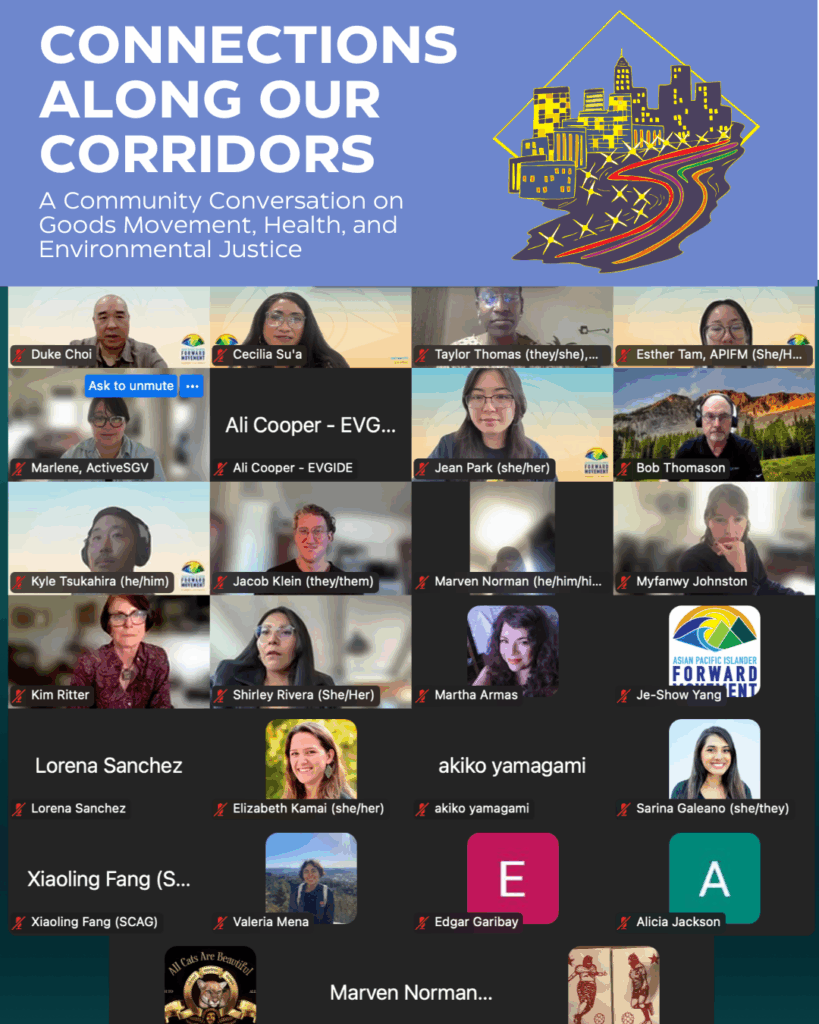
On Thursday, May 29, the Clean Air SGV team virtually hosted the “Connections Along Our Corridors” Community Conversation, where 35 total attendees from 20 different organizations, agencies, and communities joined together to discuss our local goods movement corridors. From community-based organizations (CBOs) to regulating agencies and impacted communities, the voices and perspectives shared were diverse, bringing together neighbors from all over the greater LA region and even reaching neighbors in the Central Valley, Central Coast, and the Bay Area who were interested in learning with us. With a bustling attendance, our conversations soon matched, as our participants touched on various aspects of local freight transportation.
Many communities across the nation benefit from or rely on exports that enter our San Pedro Bay Complex ports and are distributed through various modes of transportation. The communities nearest and along these corridors bear the brunt of the environmental emissions along the way. While different organizers and community members take action to help mitigate pollution in their neighborhoods, we wanted to hold space for us all to connect and build upon new relationships as we navigate different challenges for air quality and environmental justice. Facilitated by program manager Duke Choi, this online discussion brought together community organizers, residents, and agency workers to discuss their experiences of these corridors and explore potential plans or changes. We were able to hold space for both a large group discussion and small group breakout rooms, allowing participants to engage and share their experiences about our local corridors and futures more intimately.

What was Discussed?
Community Engagement, Community Collaboration, and Community Concerns!
Community engagement is essential for effective organizing, but some associated challenges include difficulties in activating community members and providing accessible information. Agencies and CBOs alike should prioritize accessibility in their resource development, taking into account the communities they serve. For example, relying on apps and social media may not be accessible to elderly folks or other communities. Conversely, several participants, both residents and organizers, noted that door-to-door knocking is particularly effective. Relatedly, frontline communities and younger organizers can help shift public opinions by engaging with people who have a status quo bias, such as some seniors they may work with.
Community engagement can also be used to expose community members to more local opportunities to engage with sustainable practices and alternatives. Additionally, keeping supporters updated on local civic engagement opportunities can highlight their agency and power as community members.
Many of our concerns were connected! Folks are tired of being forced to compete over limited resources and with other communities who are also in need. Community members and organizers alike reported dissatisfaction with current agencies not regularly collecting data or making data publicly accessible. In the same vein, all attendees shared concerns about how local goods movement services are currently impacting their nearby communities; there is an evident interconnectedness of issues along the corridors of various pollution sources impacting people.
Community collaboration can help fill gaps that overseeing agencies might miss, such as using community-based participatory research to collect local air quality data that would otherwise be unavailable or go unmonitored.
Community collaboration can also be used to help expand organizers’ influence and capacity building. Organizing groups can also support each other with simple actions, such as reaching out to share events of local organizations and signing on to letters of support. On a larger scale, organizers and residents can attend other clean air-related events and activities across the state and even the nation to connect with more peers and learn outside of their communities. After all, many policies and federal agencies impacting our local communities are regional. Some regional issues mentioned during our large and small groups are listed below:
- Emission reduction plans
- SB 4 Climate Bond
- Cap-and-Trade Program
- LA Metro’s new initiative to partner with CBOs
- Urban Greening Project in 710 Corridor
- Metro’s Bus Rapid Transit (BRT) changes
Shared Tips for Effective Engagement and Community Collaboration:
- Be honest and accurate about issues and what your organization/agency can do for the community
- Meet communities where they’re at– this can mean collaborating with organizations that have already established a local supportive base and/or are doing related work
- Connect with community leaders and partners out in the neighborhoods who have the time and capacity to work together
- Foster an ecosystem of support
- Create educational trainings and workshops that help community members understand policies impacting them– training series are especially useful
- Host Clean Air Day events with educational activities and further opportunities to stay involved
- Always have at least one call-to-action ready during any outreach efforts
- Remember: Actions don’t have to be “big” actions all the time– everything counts!



